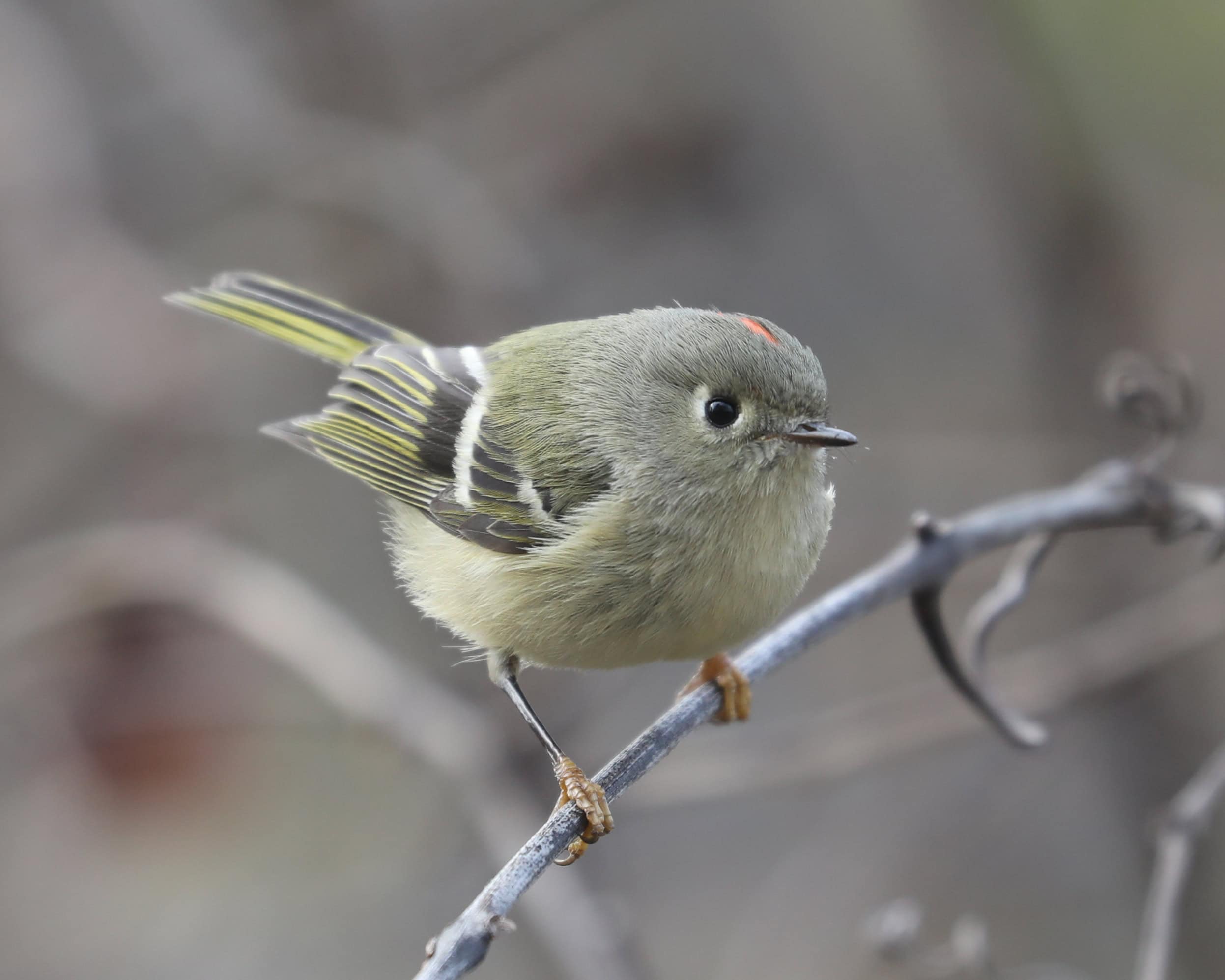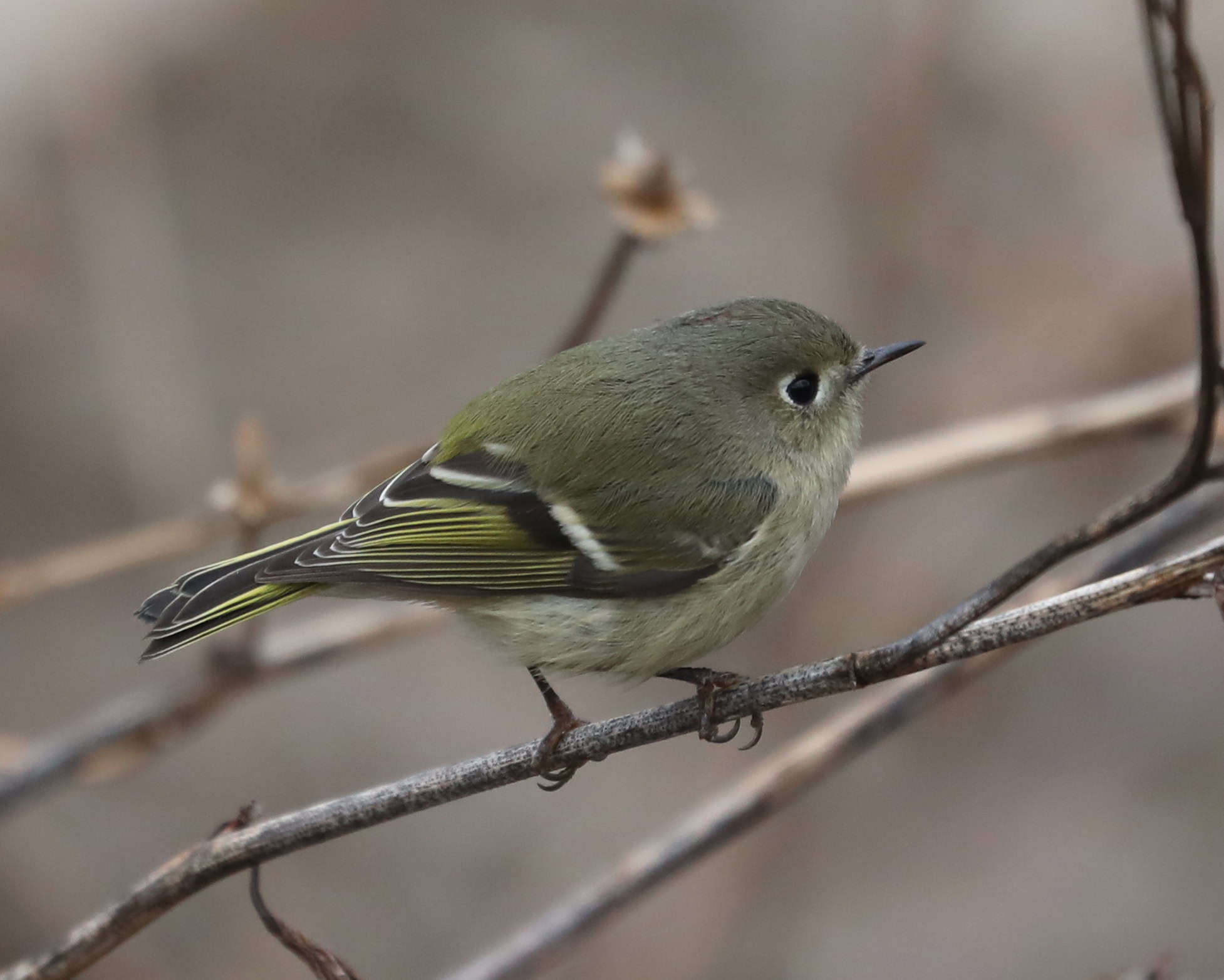Little Kings: Ruby-crowned Kinglet
I make a point of going bird watching every day. Sometimes that means a fun trip to a beautiful natural area, sometimes it’s watching birds in my backyard as my dog chases her tennis ball. During the winter, when the sun sets so early, my daily birding is sometimes just exploring the small patch of bushes and trees next to the parking lot behind the Mechanicsburg Wild Birds Unlimited. A few days ago that’s all my schedule allowed. It was cold and windy, and there were few birds to be seen, but I managed to find seven species, including a solitary Blue Jay perched in a tree, a Mourning Dove and 26 European Starlings flying overhead, a distant Bald Eagle circling high in the sky, and the usual vultures (two Black Vultures and ten Turkey Vultures today), roosting on the cell phone tower south of Carlisle Pike.
The highlight that day was a tiny Ruby-crowned Kinglet (to give you an idea of how tiny – a kinglet weighs about half as much as a goldfinch). I found it in some thick bushes in a gully, sheltered from the worst of the wind. It was energetically hopping from branch to branch, apparently trying to determine how much of a threat I was. He perched long enough for me to take the photo above. You can see the little patch of red feathers on the top of his head that give the species its name. Only the males have those red feathers, but they’re usually out of sight, covered by olive-colored feathers (check out the male kinglet in the photo below). When Ruby-crowned Kinglets get really excited or agitated, they raise the feathers on top of their head and it looks like a red flame.
Ruby-crowned Kinglets, one of Pennsylvania’s smallest birds, nests across most of Canada’s forests, in the mountains of western North America, and in northern New England. A single kinglet nest can contain as many as 12 eggs, more than any other North American songbird. We see Ruby-crowned Kinglets in the Susquehanna Valley here from mid-September through early May, especially in October and April, when large numbers are migrating through Pennsylvania.
Little Kings: Ruby-crowned Kinglet
I make a point of going bird watching every day. Sometimes that means a fun trip to a beautiful natural area, sometimes it’s watching birds in my backyard as my dog chases her tennis ball. During the winter, when the sun sets so early, my daily birding is sometimes just exploring the small patch of bushes and trees next to the parking lot behind the Mechanicsburg Wild Birds Unlimited. A few days ago that’s all my schedule allowed. It was cold and windy, and there were few birds to be seen, but I managed to find seven species, including a solitary Blue Jay perched in a tree, a Mourning Dove and 26 European Starlings flying overhead, a distant Bald Eagle circling high in the sky, and the usual vultures (two Black Vultures and ten Turkey Vultures today), roosting on the cell phone tower south of Carlisle Pike.
The highlight that day was a tiny Ruby-crowned Kinglet (to give you an idea of how tiny – a kinglet weighs about half as much as a goldfinch). I found it in some thick bushes in a gully, sheltered from the worst of the wind. It was energetically hopping from branch to branch, apparently trying to determine how much of a threat I was. He perched long enough for me to take the photo above. You can see the little patch of red feathers on the top of his head that give the species its name. Only the males have those red feathers, but they’re usually out of sight, covered by olive-colored feathers (check out the male kinglet in the photo below). When Ruby-crowned Kinglets get really excited or agitated, they raise the feathers on top of their head and it looks like a red flame.
Ruby-crowned Kinglets, one of Pennsylvania’s smallest birds, nests across most of Canada’s forests, in the mountains of western North America, and in northern New England. A single kinglet nest can contain as many as 12 eggs, more than any other North American songbird. We see Ruby-crowned Kinglets in the Susquehanna Valley here from mid-September through early May, especially in October and April, when large numbers are migrating through Pennsylvania.
About The Author
Dan Hinnebusch is the Ornithologist for Wild Birds Unlimited. Click to learn more.





